How to Prepare Salmon: What To Buy and How To Cook It
Jump To Recipe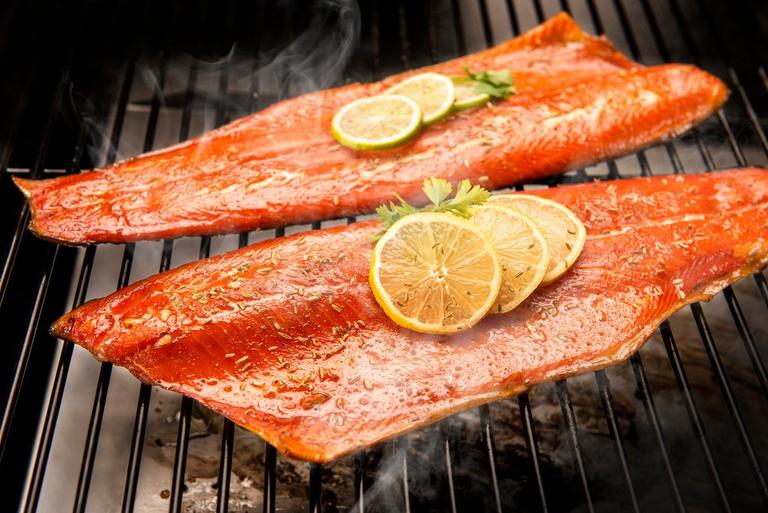
While salmon may not be the first thing you cook on your Traeger (that honor probably goes to pulled pork or ribs), it will definitely be one of the best. Rich and fatty, salmon can stand up to high heat grilling but also turns out beautifully when smoked low and slow. But what kind of salmon should you buy? Wild? Farmed? Fresh? Frozen? Should you leave the skin on? And how to best prepare salmon for smoking? Read on to learn the answers to these questions and more.
Go Wild
In an ideal world, the salmon you eat would all be wild caught. Wild salmon season starts in May and goes as late as mid-September, but wild salmon is available frozen year-round. (Frozen might not sound ideal, but if the fish was flash frozen and kept at a constant temperature, it should still retain its high quality.)
There are seven species of Pacific salmon and one of Atlantic salmon. Of these, wild Atlantic salmon is now quite rare and not available commercially in the United Staes; you will only find it domestically in a few rivers in Maine. This means that any Atlantic salmon you see at the market is almost guaranteed to be farmed. (More on salmon farming later.) Of the seven varieties of Pacific salmon, you’ll most likely find one of the five listed below, most of which come from Alaska.
King – Also called Chinook, this large salmon averages about 20 pounds, but can grow to 50 pounds. It usually is the first fresh wild salmon available and is prized for its rich flavor, high fat content, and meltingly tender texture.
Sockeye – Sockeye is a smaller species of salmon averaging about 6 pounds. Compared to king, it has a firmer texture and a stronger flavor. You can find it from May through July..
Coho – Silvery on the outside with a deep orange flesh inside, Coho, which weighs about 12 pounds, has a more delicate flavor and a texture that’s firm and meaty. It usually becomes available in late summer
Chum – Marketers are trying to get folks to call this fish by a name closer to its scientific name: Keta. (Hard to blame them.) Yet, chum, though not as prized as king or sockeye, is a favorite for smoking thanks to its mild flavor and lower fat content.
Pink – Pinks, the smallest of the five species at about 2½ pounds, have a light rosy flesh. They also have the second highest fat content after king. Often canned, pinks are becoming more available fresh and frozen, which is great for those who like their salmon mild in flavor.
How to Buy Fresh Salmon
As already noted, if possible, buy wild. Thanks to their active lives and diet, wild salmon have a meaty, succulent texture and a very rich almost fatty flavor. To make sure you’re buying sustainable and truly wild salmon, look for the words “wild” and “Pacific” on the label or on the signs at the fish counter. Salmon from Alaska is almost always wild.
If you have the choice, you might want to try buying your fish from a specialty retailer who may have the freshest pick. But no matter if you’re at your favorite fish monger or the big-box retailer, you should look for these things when buying fresh salmon. Note: If buying fresh salmon, plan to cook it the day you buy it. (If you can’t cook it on the same day, wrap it well and refrigerate it for no more than 2 days.)
- Look for tight flesh with no gaps, which can signify age or rough handling. The fillets should also be set out on fresh-looking ice.
- If you have a choice of salmon fillets, those from the head end have a more uniform thickness and so will cook more evenly.
- For whole salmon, check that the eyes look clear and moist, and the grills are pink or red.
Which cut of salmon to buy
You can buy salmon (both wild and farmed) any number of ways including the whole fish, a whole side, fillets, or steaks. Once you’ve chosen your preferred cut, learning how to prepare salmon can open up a world of culinary possibilities.
FILLETS – The most common way to buy and cook salmon is as fillets, which are boneless and either skin on or skin off. They can be large piece or small. Below are some of the more common fillet options you’ll find.
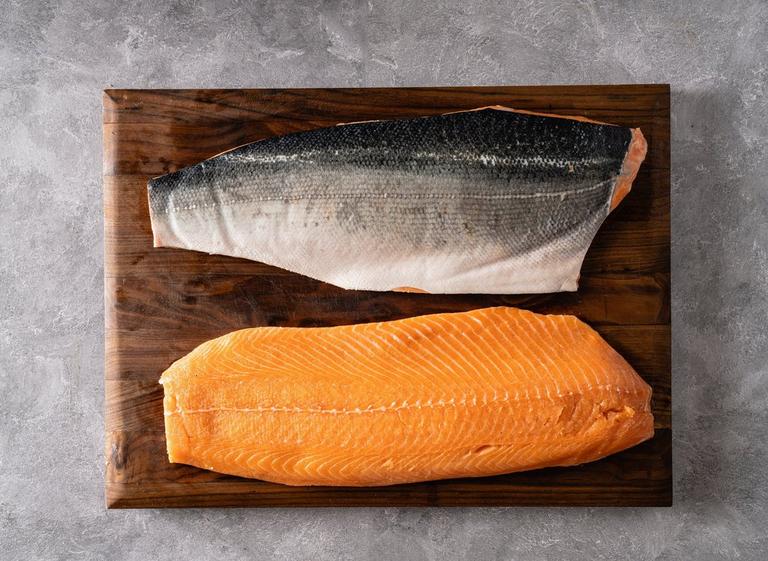
Salmon Side: A whole side of salmon is perfect for feeding a crowd. These are fun to cook and look great at the table, including this whole side of salmon with avocado salsa. (Our large spatula makes transferring it easy.) A whole side usually comes skin-on and may still include tiny pin bones, which we tell you how to remove later. A whole side or even just a large fillet, is also a good choice when you want to cut the individual portions yourself; it also means the fish was less handled while in the case. A whole side of salmon is also our choice when it comes to making our own smoked salmon.
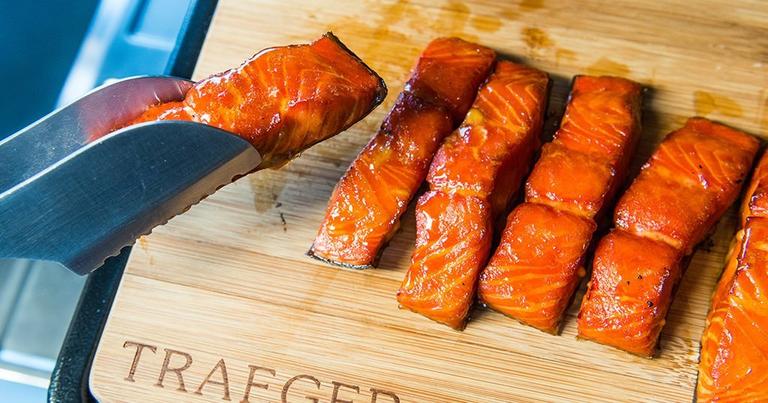
Cut Fillets: You may notice that salmon fillets at the fish counter comes in different shapes. That, in large part, is determined by where and how they were cut since they come from various parts of the fish.
- A common fillet cut comes from cutting a salmon side crosswise. This results in a strip-like fillet that’s fatter on one end (the side from the top of the fish or the loin) and thinner on the other (the belly side). You can see this shape in this delicious Sweet & Spicy Sriracha Salmon.
- Thinner filets cut from the tail end may look almost triangular and taste leaner and lighter.
- A fillet of just the thin belly portion, is rich and fatty and a favorite in Japanese cuisine.
- A fillet of the whole loin of the fish is a premium piece that’s also called, fittingly, the Tsar cut. When the loin is cut into individual portions, it may be called a center-cut fillet, which is shown off to perfection in this recipe for Simple Glazed Salmon Fillets.
- The salmon collar is the fatty morsel of meat found just under the gills. While not a common cut, it’s prized for its deep flavor and extreme tenderness. Almost impossible to overcook, these inexpensive, boneless bites take especially well to high heat-cooking methods like grilling.

SALMON STEAKS – This U-shaped piece of salmon is a cross section that includes two sides of the fish as well a spiny backbone holding the pieces together. Because of their even thickness, salmon steaks are ideal for grilling, though some people don’t like eating around the bone. Try them grilled and topped with a corn salad as in this recipe.
WHOLE SALMON – Grilling or roasting a whole salmon makes an impressive centerpiece main that feeds a crowd. The salmon will be slit and gutted but still retains its bones and tail; the head may or may not still be on. (If on, the true salmon aficionados may fight over who gets the salmon cheeks.) Whole salmon is delicious stuffed then grilled, baked, or roasted.
What About Farmed Salmon?
In terms of sustainability, you always want to go with wild salmon, and most would say the same is true for flavor and nutritional value. As mentioned earlier, wild Atlantic salmon is not available commercially in the United States. If you see Atlantic salmon at the market, it’s farmed. (Note that some Pacific salmon is also being farmed in Chile and Canada, too.)
There are many environmental concerns with farmed salmon, including the spread of diseases and crowded pens that create dead zones in the surrounding water. Because if their habitat—being fed and not moving as much as wild salmon—they have a softer texture, milder flavor, lighter color, and much higher fat content.
Farmed salmon is both widely available year-round, consistent, and convenient, which makes it hard to resist. The good news it that advances in aquaculture have improved practices and so some farmed salmon is more sustainable than others. To find out which farmed salmon is a good choice, check out this Sustainable Salmon Guide put out by Seafood Watch, an advocacy group affiliated with the Monterey Bay Aquarium, which as part of its mission, educates consumers on sustainable fish choices.
What About Frozen Salmon?
If the salmon was flash frozen, meaning it was frozen rapidly to subzero temperatures shortly after being caught and processed, there should be virtually no decrease in the fish’s quality. This means you can buy high-quality wild salmon any time of the year. (Flash freezing also ensures quality scallops, shrimp, and other seafood.) That said, it’s important that after this deep freeze, the fish is kept frozen as it makes its way to you. Here are tips for buying frozen salmon:
- Avoid packages with signs of frost of ice crystals, which can mean the fish was thawed and refrozen, which adversely affects texture.
- Press on the frozen fish; if not rock hard, skip it.
- Once you get your frozen fish home, follow the directions on the package for storing it and thawing it.
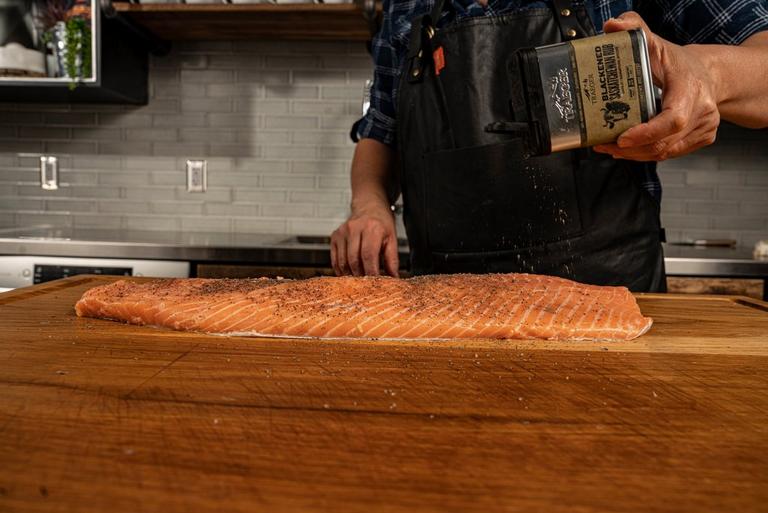
How to Prepare Salmon for Cooking
The good news about America’s favorite fish is that it usually needs very little in terms of preparation. Most fillets you buy will be just that—fillets—meaning all bones have been removed, but it’s always good to double check. Here’s how to prepare salmon for cooking:
First, check for pin bones and remove them.
Pin bones are thin, flexible bones that run down the length of each side of salmon and are spaced about ½ inch apart. Some fishmongers remove them before selling, but it’s best to make sure before cooking as these bones can be a choking hazard. To check, run your fingers lengthwise down the center of the fillet in both directions. You will feel the tip of the bone.
When you feel a bone, remove it by grabbing the tip of the bone (with tweezers, clean pliers, or even nimble fingers) and pulling it out in same direction it was residing in the fish. (Pulling in the opposite direction can cause a gap in the flesh.)
What about the skin?
If your fish came with the skin still on, you have two choices for how to prepare salmon and cook it. You can cook it with the skin on or remove the skin. There are methods for cooking salmon—the best being pan searing—that make the skin cook up irresistibly crisp. But even in other cases, cooking a salmon fillet with the skin on helps keep it moist. The exception to this is if you are poaching salmon of smoking it, in which case the skin is no help and can turn out unpleasantly rubbery.
And even if you are not a fan of salmon skin, cooking the fish with it on protects it from overcooking. It’s also easy to slide the flesh off the skin after it’s been cooked. For an easy and delicious recipe that features skin-on salmon, check out this Roasted Sheet Pan Salmon with Spring Vegetables and Pesto.
If your recipe calls for skinless salmon or you just want it that way from the start, you can remove it by placing the fillet skin side down on a cutting board. Beginning at one end (the tail end if applicable), run a sharp knife between the flesh and the skin. When some of the skin has been freed, grab it with your other hand and pull on it as you simultaneously slide the knife down the fillet in the opposite direction.
How to Flavor
When it comes to how to prepare salmon, flavoring goes a long way. That’s because the fish’s rich nature can take to all kinds of flavoring without being overwhelmed. It takes well to all kinds of flavorings from rubs (we can’t talk enough about our Fin & Feather Rub) to glazes, marinades, brines, toppings, such as salsas and sauces, and more.
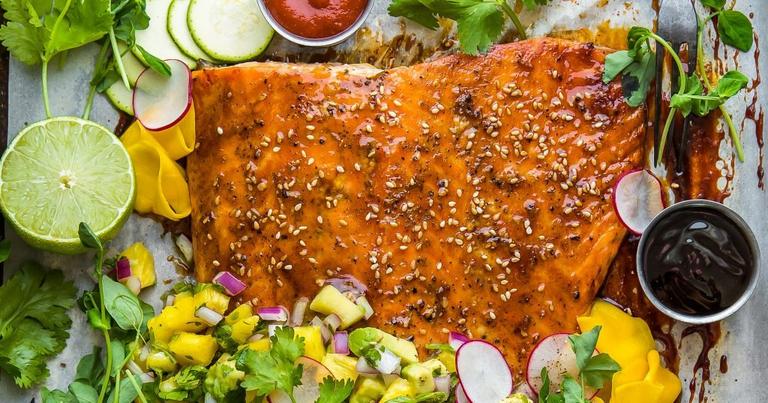
How to Cook Salmon
Salmon is incredibly versatile. On the Traeger website and app, you’ll find recipes for salmon tacos, burgers, dips, jerky, sandwiches, and even salmon “candy,” along with more typical grilled and smoked salmon recipes.
The Traeger can cook salmon low and slow for smoking it or can grill salmon with high heat. For how to bake salmon, set the grill at a moderate 350°F and cook until done to your liking. For how to roast salmon, increase the heat to about 425°F and cook for about 15 minutes for a perfect medium.
The great thing about salmon is that because it’s so rich, it’s hard to overcook it.
Look below for more specific ways to cook the Traegerhood’s favorite fish:
Grilled Blackened Saskatchewan Salmon
Grilled Sriracha Salmon with Avocado and Pineapple Salsa
Flat Top Teriyaki Salmon Bowls
Smoked Salmon Salad with Dill and New Potatoes
How do I tell when salmon is done?
There’s no single right answer here. That’s because people like this fish cooked to all different donenesses from practically raw inside with just a seared top to cooked all the way until fully opaque and flaky. Just to give you more of an idea of the range, the USDA will tell you to cook salmon to an internal temperature of 145°F to ensure safety. However, most cooks will want to take the salmon off the heat well before that, at around 125°F for medium, which will be opaque but still silky.
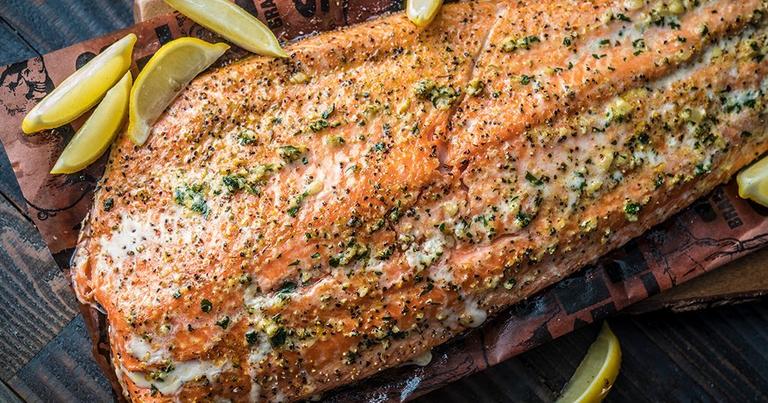
FAQ
What is the white stuff I sometimes see when cooking salmon? Sometimes when you cook salmon, it oozes a white substance. While harmless, it doesn’t look so hot. It’s called albumin, and it’s a protein that solidifies as the salmon cooks. It most often appears when you cook salmon hot and fast, which means lowering the temperature can help. If that doesn’t work, simply scrape off that white gunk off before serving.
Is steelhead trout a kind of salmon? Steelhead trout gets mistaken for salmon because of its pink color and similar texture and flavor. However, it’s a different fish. That said, you can sub it for salmon in most recipes. Just be aware that because its fillets are thinner, it will cook quicker.
Do I need to cook salmon on a cedar plank? Not when you use a Traeger! People grill salmon on cedar to impart some wood-fired flavor, but Traeger pellets will impart that flavor and let you choose from among a variety of hardwoods.
Citrus Salmon
by Traeger Kitchen
27 Reviews
Prep Time
10 Min
Cook Time
15 Min
Serves
2
Pellets
Cherry
Slather that salmon in butter, lemon, and dill for a zesty flavor that’s sure to please any eater.
Ingredients
main
| 2 Tablespoon | Unsalted butter, softened |
| 1/2 Teaspoon | lemon zest |
| 1 Teaspoon | lemon juice |
| 2 Teaspoon | chopped fresh dill, plus more for garnish |
| 1/2 Teaspoon | kosher salt |
| To Taste | Black pepper |
| 4 | (8 oz) skin-on salmon fillets |
| 4 Slices | lemon |
1
When ready to cook, set the Traeger temperature to 350°F and preheat with the lid closed for 15 minutes.
2
In a small bowl, mix together the butter, lemon zest, lemon juice, dill, salt, and pepper.
3
Generously slather the top of each salmon fillet with the lemon-dill butter. Top each fillet with a lemon slice.
4
Insert the probe horizontally into the center of a salmon fillet. Place the fillets, skin-side down, directly on the grill grates. Cook until the internal temperature reaches 130°F for medium-rare, 15-20 minutes, or to your desired temperature.
5
Remove the salmon from the grill. Garnish with more dill and serve. Enjoy!